国际经济学考试试题完美版,含答案.
(完整)国际经济学考试题库(答案版)
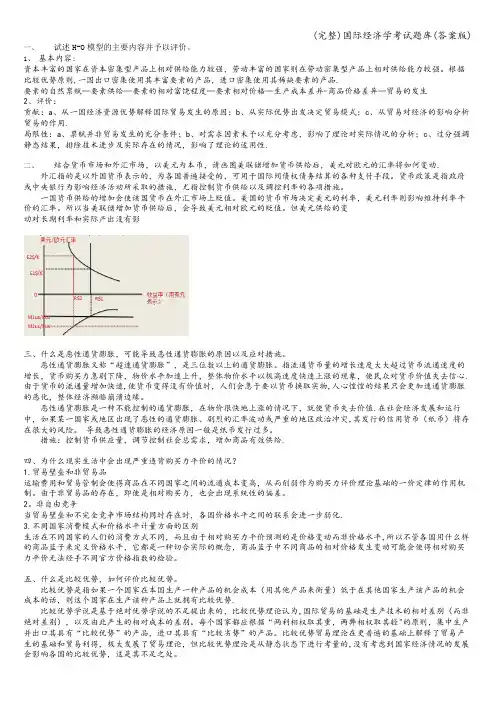
一、试述H-O模型的主要内容并予以评价。
1、基本内容:资本丰富的国家在资本密集型产品上相对供给能力较强,劳动丰富的国家则在劳动密集型产品上相对供给能力较强。
根据比较优势原则,一国出口密集使用其丰富要素的产品,进口密集使用其稀缺要素的产品.要素的自然禀赋—要素供给—要素的相对富饶程度—要素相对价格—生产成本差异-商品价格差异—贸易的发生2、评价:贡献:a、从一国经济资源优势解释国际贸易发生的原因;b、从实际优势出发决定贸易模式;c、从贸易对经济的影响分析贸易的作用.局限性:a、禀赋并非贸易发生的充分条件;b、对需求因素未予以充分考虑,影响了理论对实际情况的分析;c、过分强调静态结果,排除技术进步及实际存在的情况,影响了理论的适用性.二、结合货币市场和外汇市场,以美元为本币,请画图美联储增加货币供给后,美元对欧元的汇率将如何变动.外汇指的是以外国货币表示的,为各国普遍接受的,可用于国际间债权债务结算的各种支付手段。
货币政策是指政府或中央银行为影响经济活动所采取的措施,尤指控制货币供给以及调控利率的各项措施。
一国货币供给的增加会使该国货币在外汇市场上贬值。
美国的货币市场决定美元的利率,美元利率则影响维持利率平价的汇率。
所以当美联储增加货币供给后,会导致美元相对欧元的贬值。
但美元供给的变动对长期利率和实际产出没有影三、什么是恶性通货膨胀,可能导致恶性通货膨胀的原因以及应对措施。
恶性通货膨胀又称“超速通货膨胀”,是三位数以上的通货膨胀。
指流通货币量的增长速度大大超过货币流通速度的增长,货币购买力急剧下降,物价水平加速上升,整体物价水平以极高速度快速上涨的现象,使民众对货币价值失去信心.由于货币的流通量增加快速,使货币变得没有价值时,人们会急于要以货币换取实物,人心惶惶的结果只会更加速通货膨胀的恶化,整体经济濒临崩溃边缘。
恶性通货膨胀是一种不能控制的通货膨胀,在物价很快地上涨的情况下,就使货币失去价值.在社会经济发展和运行中,如果某一国家或地区出现了恶性的通货膨胀、剧烈的汇率波动或严重的地区政治冲突,其发行的信用货币(纸币)将存在很大的风险。
国际经济学试卷试题包括答案.docx
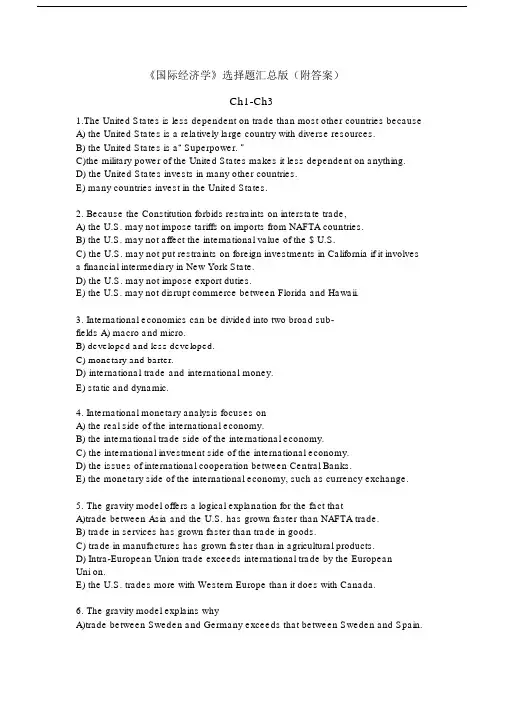
《国际经济学》选择题汇总版(附答案)Ch1-Ch31.The United States is less dependent on trade than most other countries becauseA)the United States is a relatively large country with diverse resources.B)the United States is a“ Superpower. ”C)the military power of the United States makes it less dependent on anything.D)the United States invests in many other countries.E)many countries invest in the United States.2. Because the Constitution forbids restraints on interstate trade,A)the U.S. may not impose tariffs on imports from NAFTA countries.B)the U.S. may not affect the international value of the $ U.S.C)the U.S. may not put restraints on foreign investments in California if it involves a financial intermediary in New York State.D)the U.S. may not impose export duties.E)the U.S. may not disrupt commerce between Florida and Hawaii.3.International economics can be divided into two broad sub-fields A) macro and micro.B) developed and less developed.C) monetary and barter.D) international trade and international money.E) static and dynamic.4.International monetary analysis focuses onA)the real side of the international economy.B)the international trade side of the international economy.C)the international investment side of the international economy.D)the issues of international cooperation between Central Banks.E)the monetary side of the international economy, such as currency exchange.5.The gravity model offers a logical explanation for the fact thatA)trade between Asia and the U.S. has grown faster than NAFTA trade.B) trade in services has grown faster than trade in goods.C) trade in manufactures has grown faster than in agricultural products.D) Intra-European Union trade exceeds international trade by the EuropeanUni on.E) the U.S. trades more with Western Europe than it does with Canada.6.The gravity model explains whyA)trade between Sweden and Germany exceeds that between Sweden and Spain.B)countries with oil reserves tend to export oil.C)capital rich countries export capital intensive products.D)intra-industry trade is relatively more important than other forms of tradebetween neighboringcountries.E)European countries rely most often on natural resources.7. Why does the gravity model work?A)Large economies became large because they were engaged in international trade.B)Large economies have relatively large incomes, and hence spend more on governm ent promotion of trade and investment.C)Large economies have relatively larger areas which raises the probability that a pro ductive activity will take place within the borders of that country.D)Large economies tend to have large incomes and tend to spend more on impor ts.E) Large economies tend to avoid trading with small economies.8.We see that the Netherlands, Belgium, and Ireland trade considerably more with the United States than with many other countries.A)This is explained by the gravity model, since these are all large countries.B)This is explained by the gravity model, since these are all small countries.C)This fails to be consistent with the gravity model, since these are smallcountri es.D)This fails to be consistent with the gravity model, since these are large countries.E)This is explained by the gravity model, since they do not share borders.9.In the present, most of the exports from Chinaare A) manufactured goods.B) services.C)primary products including agricultural.D) technology intensive products.E) overpriced by world market standards.10.A country engaging in trade according to the principles of comparative advantage gains from trade because itA) is producing exports indirectly more efficiently than it could alternatively.B) is producing imports indirectly more efficiently than it could domestically.C) is producing exports using fewer labor units.D) is producing imports indirectly using fewer labor units.E) is producing exports while outsourcing services.11.The Ricardian model attributes the gains from trade associated with the principle o f comparative advantage result toA) differences in technology.B)differences in preferences.C)differences in labor productivity.D)differences in resources.E)gravity relationships among countries.12. A nation engaging in trade according to the Ricardian model will find itsconsump tion bundleA)inside its production possibilities frontier.B)on its production possibilities frontier.C)outside its production possibilities frontier.D)inside its trade-partner's production possibilities frontier.E)on its trade-partner's production possibilities frontier.13.Assume that labor is the only factor of production and that wages in the United Sta tes equal $20 per hour while wages in Japan are $10 per hour. Production costs would be lower in the United States as compared to Japan ifA)U.S. labor productivity equaled 40 units per hour and Japan's 15 units per hour.B)U.S. labor productivity equaled 30 units per hour and Japan's 20 units per hour.C)U.S. labor productivity equaled 20 units per hour and Japan's 30 units per hour.D)U.S. labor productivity equaled 15 units per hour and Japan's 25 units per hour.E)U.S. labor productivity equaled 15 units per hour and Japan's 40 units per hour.14.In a two-country, two-product world, the statement“ Germanyenjoys acomparativ e advantage over France in autos relative toships ”is equivalent toA) France having a comparative advantage over Germany in ships.B) France having a comparative disadvantage compared to Germany in autos and ship s.C) Germany having a comparative advantage over France in autos and ships.D) France having no comparative advantage over Germany.E) France should produce autos.15.If the United States' production possibility frontier was flatter to the widget axis, whereas Germany's was flatter to the butter axis, we know thatA)the United States has no comparative advantageB)Germany has a comparative advantage in butter.C)the U.S. has a comparative advantage in butter.D)Germany has comparative advantages in both products.E)the U.S. has a comparative disadvantage in widgets.Ch4-Ch51.The Ricardian model of international trade demonstrates that trade can bemutually beneficial. Why, then, do governments restrict imports of some goods?A)Trade can have substantial effects on a country's distribution of income.B)The Ricardian model is often incorrect in its prediction that trade can bemutually beneficial.C)Import restrictions are the result of trade wars between hostile countries.D)Imports are only restricted when foreign-made goods do not meet domestic standar ds of qualityE) Restrictions on imports are intended to benefit domestic consumers.2.Japan's trade policies with regard to rice reflect the fact thatA) japanese rice farmers have significant political power.B) Japan has a comparative advantage in rice production and therefore exports most o f its rice crop.C) there would be no gains from trade available to Japan if it engaged in free trade in r ice.D) there are gains from trade that Japan captures by engaging in free trade in rice.E) Japan imports most of the rice consumed in the country.3.In the specific factors model, which of the following is treated as a specific factor?A)LaborB)LandC)ClothD)FoodE)Technology4.The specific factors model assumes that there are ________ goods and ________ fa ctor(s) of production.A) two; threeB) two; two C)two; one D)three; two E)four; three5.The slope of a country's production possibility frontier with cloth measured on the horizontal and food measured on the vertical axis in the specific factors model is equa l to ________ and it ________ as more cloth is produced.A)-MPLF/MPLC; becomes steeperB)-MPLF/MPLC; becomes flatterC)-MPLF/MPLC; is constantD)-MPLC/MPLF; becomes steeperE)-MPLC/MPLF; is constant6.Under perfect competition, the equilibrium price of labor used to produce clothwill be equal toA)the slope of the production possibility frontier.B)the average product of labor in the production of cloth times the price of cloth.C)the ratio of the marginal product of labor in the production of cloth to the marginal product of labor in the production of food times the ratio of the price of cloth. to the price of food.D)the marginal product of labor in the production of cloth times the price of cloth.E)the price of cloth divided by the marginal product of labor in the production of clot h.7.In the specific factors model, which of the following will increase the quantity ofla bor used in cloth production?A)an increase in the price of cloth relative to that of foodB) an increase in the price of food relative to that ofcloth C) a decrease in the price of laborD) an equal percentage decrease in the price of food and clothE) an equal percentage increase in the price of food and cloth8.A country that does not engage in trade can benefit from trade only ifA)it has an absolute advantage in at least one good.B)it employs a unique technology.C)pre-trade and free-trade relative prices are not identical.D)its wage rate is below the world average.E)pre-trade and free-trade relative prices are identical.9.In the specific factors model, the effects of trade on welfare are ________ for mobil e factors, ________ for fixed factors used to produce the exported good, and ________ for fixed factors used to produce the imported good.A)ambiguous; positive; negativeB) ambiguous; negative; positive C)positive; ambiguous; ambiguous D)negative; ambiguous; ambiguous E)positive; positive; positive10.The effect of trade on specialized employees of import-competing industries willb e ________ jobs and ________ pay because they are relatively ________.A)fewer; lower; mobileB)fewer; lower; immobileC)more; lower; immobileD)more; higher; mobileE)more; higher; immobile11. There is a bias in the political process against free trade becauseA)there is a high correlation between the volume of imports and the unemployment ra te.B)the gains from free trade cannot be measured.C)those who gain from free trade can't compensate those who lose.D)foreign governments make large donations to U.S. political campaigns.E) those who lose from free trade are better organized than those who gain.12.In the 2-factor, 2 good Heckscher-Ohlin model, the two countries differin A)tastes and preferences.B)military capabilities.C)the size of their economies.D)relative abundance of factors of production.E)labor productivities.13.If a country produces good Y (measured on the vertical axis) and good X (measure d on the horizontal axis), then the absolute value of the slope of its production possibil ity frontier is equal toA)the opportunity cost of good X.B) the price of good X divided by the price of good Y.C) the price of good X divided by the price of goodY. D) the opportunity cost of good Y.E)the cost of capital (assuming that good Y is capital intensive) divided by the costof labor.14.In the 2-factor, 2 good Heckscher-Ohlin model, trade will ________ the owners ofa country's ________ factor and will ________ the good that uses that factor intensiv ely.A)benefit; abundant; exportB)harm; abundant; importC)benefit; scarce; exportD)benefit; scarce; importE)harm; scarce; export15.The assumption of diminishing returns in the Heckscher-Ohlin model means that, unlike in the Ricardian model, it is likely thatA) countries will consume outside their production possibility frontier.B) countries will benefit from free international trade.C) countries will not be fully specialized in one product.D)comparative advantage will not determine the direction of trade.E)global production will decrease under trade.16.If Japan is relatively capital rich and the United States is relatively land rich, and if food is relatively land intensive then trade between these two, formerly autarkic coun tries will result inA)an increase in the relative price of food in the U.S.B)an increase in the relative price of food in Japan.C)a global increase in the relative price of food.D)a decrease in the relative price of food in both countries.E)an increase in the relative price of food in both countries.17.Starting from an autarky (no-trade) situation with Heckscher-Ohlin model, if Coun try H is relatively labor abundant, then once trade beginsA) rent will be unchanged but wages will rise in H.B) wages and rents should rise in H.C) wages and rents should fall in H.D) wages should fall and rents should rise in H.E) wages should rise and rents should fall in H.18.The Leontieff ParadoxA)failed to support the validity of the Heckscher-Ohlin model.B)supported the validity of the Ricardian theory of comparative advantage.C)supported the validity of the Heckscher-Ohlin model.D)failed to support the validity of the Ricardian theory.E)proved that the U.S. economy is different from all others.19. Which of the following is an assertion of the Heckscher-Ohlin model?A)Factor price equalization will occur only if there is costless mobility of all factors a cross borders.B)An increase in a country's labor supply will increase production of both the capital-intensive and the labor-intensive good.C)In the long-run, labor is mobile and capital is not.D)The wage-rental ratio determines the capital-labor ratio in a country's industr ies.E)Factor endowments determine the technology that is available to a country, which determines the good in which the country will have a comparative advantage.20. Which of the following is an assertion of the Heckscher-Ohlin model?A)An increase in a country's labor supply will increase production of the labor-i ntensive good and decrease production of the capital-intensive good.B)An increase in a country's labor supply will increase production of both the capital-intensive and the labor-intensive good.C)In the long-run, labor is mobile and capital is not.D)Factor price equalization will occur only if there is costless mobility of all factors a cross borders.E)Factor endowments determine the technology that is available to a country, which determines the good in which the country will have a comparative advantage.Ch6-Ch101.If the ratio of price of cloth (PC) divided by the price of food (PF) increases in thei nternational marketplace, thenA)the terms of trade of cloth exporters will improve.B)all countries would be better off.C)the terms of trade of food exporters will improve.D)the terms of trade of all countries will improve.E) the terms of trade of cloth exporters will worsen.2.If the ratio of price of cloth (PC) divided by the price of food (PF) increases in thei nternational marketplace, thenA)world relative quantity of cloth supplied will increase.B)world relative quantity of cloth supplied and demanded will increase.C)world relative quantity of cloth supplied and demanded will decrease.D)world relative quantity of cloth demanded will decrease.E)world relative quantity of food will increase.3.If the U.S. (a large country) imposes a tariff on its imported good, this will tend toA)have no effect on terms of trade.B)improve the terms of trade of the United States.C)improve the terms of trade of all countries.D)because a deterioration of U.S. terms of trade.E)raise the world price of the good imported by the United States.4.If Slovenia were a large country in world trade, then if it instituted a large set of sub sidies for its exports, this mustA)decrease its marginal propensity to consume.B)have no effect on its terms of trade.C)improve its terms of trade.D)harm its terms of trade.E)harm world terms of trade.5.Internal economies of scale arise when the cost per unitA)falls as the average firm grows larger.B)rises as the industry grows larger.C)falls as the industry grows larger.D)rises as the average firm grows larger.E)remains constant over a broad range of output.6. External economies of scale will ________ average cost when output is ________ by _______.A)reduce; increased; the industryB)reduce; increased; a firmC)increase; increased; a firmD)increase; increased; the industryE)reduce; reduce; the industry7.If some industries exhibit internal increasing returns to scale in each country, we sh ould not expect to seeA) perfect competition in these industries.B) intra-industry trade between countries.C)inter-industry trade between countries.D)high levels of specialization in both countries.E)increased productivity in both countries.8.A learning curve relates ________ to ________ and is a case of ________ returns.A) unit cost; cumulative production; dynamic decreasing returnsB)output per time period; long-run marginal cost; dynamic increasing returnsC)unit cost; cumulative production; dynamic increasing returnsD)output per time period; long-run marginal cost; dynamic decreasing returnsE)labor productivity; education; increasing marginal returns9.Patterns of interregional trade are primarily determined by ________ rather than __ ______ because factors of production are generally ________.A)external economies; natural resources; mobileB)internal economies; external economies; mobileC)external economies; population; immobileD)internal economies; population; immobileE)population; external economies; immobile10.Monopolistic competition is associatedwith A) product differentiation.B) price-taking behavior.C) explicit consideration at the firm level of the strategic impact of other firms' pricing decisions. D) high profit margins in the long run.E) increasing returns to scale.11.A firm in long-run equilibrium under monopolistic competition will earnA)positive monopoly profits because each sells a differentiated product.B)zero economic profits because of free entryC)positive oligopoly profits because each firm sells a differentiated product.D)negative economic profits because it has economies of scale.E)positive economic profit if it engages in international trade.12.The most common form of price discrimination in international tradeis A) dumping.B) non-tariff barriers.C) Voluntary Export Restraints.D) preferential trade arrangements.E) product boycotts.13.Consider the following two cases. In the first, a U.S. firm purchases 18% of a forei gn firm. In the second, a U.S. firm builds a new production facility in a foreign countr y. Both are ________, with the first referred to as ________ and the second as ______ __.A)foreign direct investment (FDI) outflows; brownfield; greenfieldB)foreign direct investment (FDI) inflows; greenfield; brownfieldC)foreign direct investment (FDI) outflows; greenfield; brownfieldD)foreign direct investment (FDI) inflows; brownfield; greenfieldE)foreign direct investment (FDI); inflows; outflows14. Specific tariffs areA)import taxes stated in specific legal statutes.B)import taxes calculated as a fixed charge for each unit of imported goods.C)import taxes calculated as a fraction of the value of the imported goods.D)the same as import quotas.E)import taxes calculated based solely on the origin country.15.A problem encountered when implementing an "infant industry" tariff isthat A) domestic consumers will purchase the foreign good regardless of thetariff. B) the industry may never "mature."C)most industries require tariff protection when they are mature.D)the tariff may hurt the industry's domestic sales.E)the tariffs fail to protect the domestic producers.16.In the country levying the tariff, the tariff will A)increase both consumer and producer surplus.B) decrease both the consumer and producer surplus.C) decrease consumer surplus and increase producer surplus.D) increase consumer surplus and decrease producer surplus.E) decrease consumer surplus but leave producers surplus unchanged.17.If the tariff on computers is not changed, but domestic computer producers shift fr om domestically produced semiconductors to imported components, then the effective rate of protection in the computer industry willA) increase.B) decreaseC) remain the same.D)depend on whether computers are PCs or "Supercomputers."E)no longer apply.18.When a government allows raw materials and other intermediate products to enter a country duty free, this generally results in a(an)A) effective tariff rate less than the nominal tariff rate.B) nominal tariff rate less than the effective tariff rate.C) rise in both nominal and effective tariff rates.D) fall in both nominal and effective tariff rates. E) rise in only the effective tariff rat e.19.Should the home country be "large" relative to its trade partners, its imposition ofa tariff on imports would lead to an increase in domestic welfare if the terms of thetra de rectangle exceed the sum of theA) revenue effect plus redistribution effect.B) protective effect plus revenue effect.C) consumption effect plus redistribution effect.D)production distortion effect plus consumption distortion effect.E)terms of trade gain.20.The efficiency case made for free trade is that as trade distortions such as tariffs ar e dismantledand removed,A) government tariff revenue will decrease, and therefore national economic welfare will decreaseB) government tariff revenue will decrease, and therefore national econo mic welfare will increase.C) deadweight losses for producers and consumers will decrease, henceincreasin g national economic welfare.D)deadweight losses for producers and consumers will decrease, hence decreasing na tional economic welfare.E)government tariff revenue will increase, hence increasing national economic welfar e.21.Which organization determines procedures for the settlement of international trade disputes?A)World BankB)World Trade OrganizationC)International Monetary OrganizationD)International Bank for Reconstruction and DevelopmentE)The League of Nations22.Today U.S. protectionism is concentratedin A) high-tech industries.B) labor-intensive industries.C) industries in which Japan has a comparative advantage.D)computer intensive industries.E)capital-intensive industries.23.The quantitative importance of U.S. protection of the domestic clothing industryis best explained by the fact thatA)this industry is an important employer of highly skilled labor.B)this industry is an important employer of low skilled labor.C)most of the exporters of clothing into the U.S. are poor countries.D)this industry is a politically well organized sector in the U.S.E)the technology involved is very advanced.欢迎下载1124.The optimum tariff is most likely to applyto A) a small tariff imposed by a small country.B) a small tariff imposed by a large country. C)a large tariff imposed by a small country. D) alarge tariff imposed by a large country. E) anad valorem tariff on a small country.25.The median voter modelA)works well in the area of trade policy.B)is not intuitively reasonable.C)tends to result in biased tariff rates.D)does not work well in the area of trade policy.E)is not widely practiced in the United States.欢迎下载12。
国际经济学考试试题
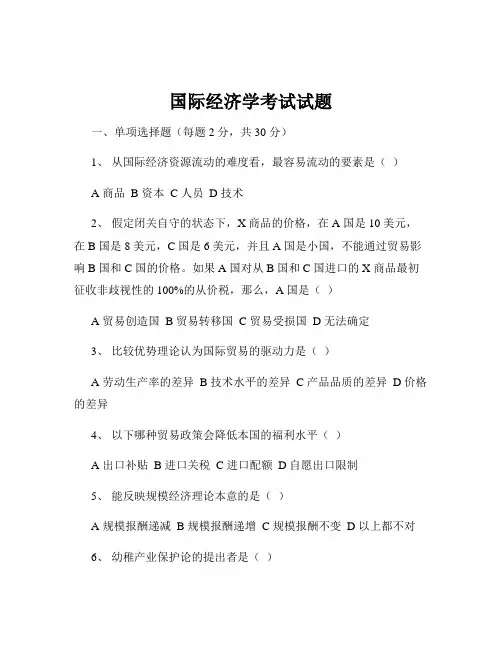
国际经济学考试试题一、单项选择题(每题 2 分,共 30 分)1、从国际经济资源流动的难度看,最容易流动的要素是()A 商品B 资本C 人员D 技术2、假定闭关自守的状态下,X 商品的价格,在 A 国是 10 美元,在 B 国是 8 美元,C 国是 6 美元,并且 A 国是小国,不能通过贸易影响 B 国和 C 国的价格。
如果 A 国对从 B 国和 C 国进口的 X 商品最初征收非歧视性的 100%的从价税,那么,A 国是()A 贸易创造国B 贸易转移国C 贸易受损国D 无法确定3、比较优势理论认为国际贸易的驱动力是()A 劳动生产率的差异B 技术水平的差异C 产品品质的差异D 价格的差异4、以下哪种贸易政策会降低本国的福利水平()A 出口补贴B 进口关税C 进口配额D 自愿出口限制5、能反映规模经济理论本意的是()A 规模报酬递减B 规模报酬递增C 规模报酬不变D 以上都不对6、幼稚产业保护论的提出者是()A 亚当·斯密B 大卫·李嘉图C 汉密尔顿D 李斯特7、当一国政府对某种产品征收进口关税时,若该产品的需求弹性大于供给弹性,生产者与消费者承担关税的程度是()A 前者大于后者B 后者大于前者C 两者相等D 不确定8、一国货币贬值对其进出口收支产生何种影响()A 出口增加,进口减少B 出口减少,进口增加C 出口增加,进口增加D 出口减少,进口减少9、在浮动汇率制下,当一国国际收支出现逆差时,该国货币汇率会()A 上升B 下降C 不变D 不确定10、以下哪项不是国际收支平衡表中的项目()A 经常项目B 资本项目C 错误与遗漏项目D 国内生产总值项目11、购买力平价理论的基础是()A 一价定律B 利率平价C 相对购买力平价D 绝对购买力平价12、国际收支调整的弹性分析法的假设前提不包括()A 不存在国际资本流动B 汇率由货币当局决定C 马歇尔勒纳条件成立D 进出口商品的供给弹性无穷大13、下列属于直接标价法的是()A 1 美元=68 人民币B 1 人民币=015 美元C 1 英镑=12 欧元D 1 欧元=085 英镑14、蒙代尔弗莱明模型主要分析在资本完全流动的情况下,()政策的有效性。
国际经济学题库(含参考答案)
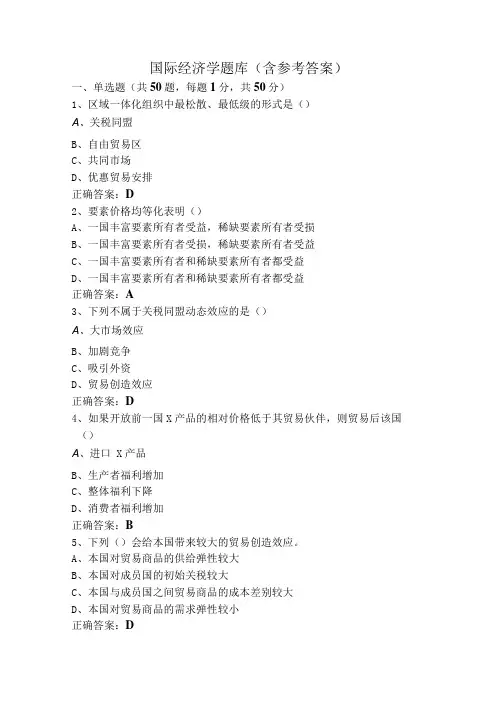
国际经济学题库(含参考答案)一、单选题(共50题,每题1分,共50分)1、区域一体化组织中最松散、最低级的形式是()A、关税同盟B、自由贸易区C、共同市场D、优惠贸易安排正确答案:D2、要素价格均等化表明()A、一国丰富要素所有者受益,稀缺要素所有者受损B、一国丰富要素所有者受损,稀缺要素所有者受益C、一国丰富要素所有者和稀缺要素所有者都受益D、一国丰富要素所有者和稀缺要素所有者都受益正确答案:A3、下列不属于关税同盟动态效应的是()A、大市场效应B、加剧竞争C、吸引外资D、贸易创造效应正确答案:D4、如果开放前一国X产品的相对价格低于其贸易伙伴,则贸易后该国()A、进口 X产品B、生产者福利增加C、整体福利下降D、消费者福利增加正确答案:B5、下列()会给本国带来较大的贸易创造效应。
A、本国对贸易商品的供给弹性较大B、本国对成员国的初始关税较大C、本国与成员国之间贸易商品的成本差别较大D、本国对贸易商品的需求弹性较小正确答案:D6、初级产品的出口价格若下降,其出口量将增加,出口总收入()A、不变B、增加C、下降D、不确定正确答案:C7、马歇尔一勒纳条件所要说明的是在供给弹性()的情况下,本币贬值能够改善贸易收支的进出口需求弹性条件。
A、零B、无穷大C、1D^大于零小于1正确答案:B8、假设中国和美国都能生产小麦和布,中国将一单位劳动时间全部生产布,可以生产50米;全部生产小麦,可以生产80千克;美国将一单位劳动时间全部生产布,可以生产40米;全部生产小麦,可以生产 100千克。
如果开放后的国际交换比价为1米布=L 8千克小麦,则下列说法正确的是()A、无法比较美国和中国的获利情况B、中国从贸易开放中获利更多C、美国和中国从贸易开放中获利相同D、美国从贸易开放中获利更多正确答案:D9、下列不属于国际收支平衡表资本项目的是()A、利息收支B、短期信贷C、短期证券买卖D、票据买卖正确答案:A10、消费者剩余是()A、消费者为了商品的消费而必须向政府支付的东西B、消费者通过低于市场价格的价格而得到的收益C、消费者购买商品所需支付的价格低于其愿意支付的价格而获得的收益D、消费者可以在各种价格水平得到的收益正确答案:C11、外汇市场中的即期交易不包含()A、套汇B、投机C、国际贸易结算D、银行同业拆借正确答案:B12、如果一个中国工人能生产3匹布或者1辆汽车,一个美国工人能生产4匹布或2辆汽车,则能促进中国与美国进行贸易并各自收益的交换比率是()A、4匹布换2辆汽车B、3匹布换1辆汽车C、3匹布换2辆汽车D、5匹布换2辆汽车正确答案:D13、国际经济学的研究对象是()A、国际商品流动B、国际收支平衡C、世界范围内的稀缺资源的最优配置D^国际人员流动正确答案:C14、根据国民收入决定方程Y=C+I+G+X-M,国际收支的吸收分析法中的“吸收”是指()A、YB、C+IC、C+I+GD、X-M正确答案:C15、开放经济条件下的宏观经济政策目标是()A、追求贸易顺差B、汇率稳定C、扩大出口D、国际收支平衡正确答案:D16、在进行贸易后,一国的收入分配会发生如下变化,()A、收入由消费者转向生产者B、受到进口商品竞争压力的国内生产者遭受损失,而出口商品的生产者则会受益C、消费者受损,生产者受益D、作为整体的国家受益,而个人则会受到损失正确答案:B17、商品和服务贸易记录在国际收支平衡表中的()A、经常项目B、误差和遗漏项目C、官方结算项目D、资本项目正确答案:A18、下列哪个行业最有可能具有内部规模经济?()A、好莱坞的电影业B、加州硅谷的半导体产业C、美国的大型农场D、北京中关村的电脑城正确答案:C19、采用()的配额分配方式,配额的福利效果与关税一样。
国际经济学练习题及答案
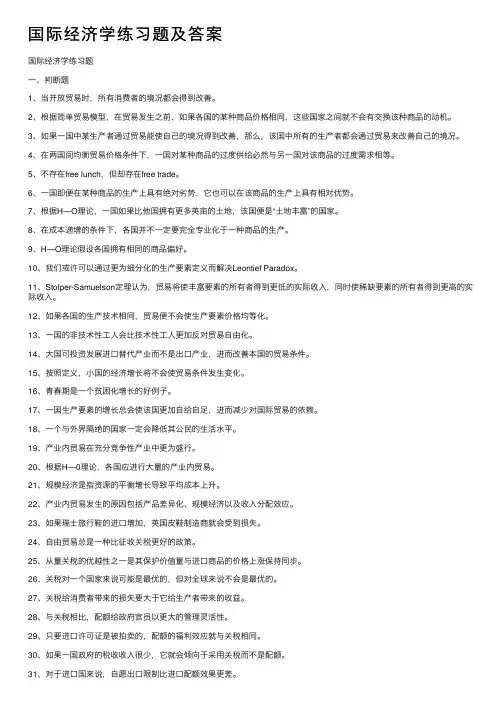
国际经济学练习题及答案国际经济学练习题⼀、判断题1、当开放贸易时,所有消费者的境况都会得到改善。
2、根据简单贸易模型,在贸易发⽣之前,如果各国的某种商品价格相同,这些国家之间就不会有交换该种商品的动机。
3、如果⼀国中某⽣产者通过贸易能使⾃⼰的境况得到改善,那么,该国中所有的⽣产者都会通过贸易来改善⾃⼰的境况。
4、在两国间均衡贸易价格条件下,⼀国对某种商品的过度供给必然与另⼀国对该商品的过度需求相等。
5、不存在free lunch,但却存在free trade。
6、⼀国即便在某种商品的⽣产上具有绝对劣势,它也可以在该商品的⽣产上具有相对优势。
7、根据H—O理论,⼀国如果⽐他国拥有更多英亩的⼟地,该国便是“⼟地丰富”的国家。
8、在成本递增的条件下,各国并不⼀定要完全专业化于⼀种商品的⽣产。
9、H—O理论假设各国拥有相同的商品偏好。
10、我们或许可以通过更为细分化的⽣产要素定义⽽解决Leontief Paradox。
11、Stolper-Samuelson定理认为,贸易将使丰富要素的所有者得到更低的实际收⼊,同时使稀缺要素的所有者得到更⾼的实际收⼊。
12、如果各国的⽣产技术相同,贸易便不会使⽣产要素价格均等化。
13、⼀国的⾮技术性⼯⼈会⽐技术性⼯⼈更加反对贸易⾃由化。
14、⼤国可投资发展进⼝替代产业⽽不是出⼝产业,进⽽改善本国的贸易条件。
15、按照定义,⼩国的经济增长将不会使贸易条件发⽣变化。
16、青春期是⼀个贫困化增长的好例⼦。
17、⼀国⽣产要素的增长总会使该国更加⾃给⾃⾜,进⽽减少对国际贸易的依赖。
18、⼀个与外界隔绝的国家⼀定会降低其公民的⽣活⽔平。
19、产业内贸易在充分竞争性产业中更为盛⾏。
20、根据H—0理论,各国应进⾏⼤量的产业内贸易。
21、规模经济是指资源的平衡增长导致平均成本上升。
22、产业内贸易发⽣的原因包括产品差异化、规模经济以及收⼊分配效应。
23、如果瑞⼠旅⾏鞋的进⼝增加,英国⽪鞋制造商就会受到损失。
《国际经济学》期末考试试卷附答案
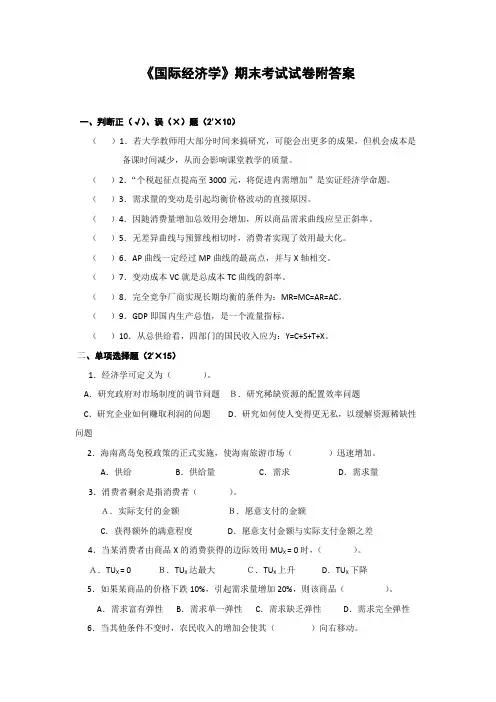
《国际经济学》期末考试试卷附答案一、判断正(√)、误(×)题(2’×10)()1.若大学教师用大部分时间来搞研究,可能会出更多的成果,但机会成本是备课时间减少,从而会影响课堂教学的质量。
()2.“个税起征点提高至3000元,将促进内需增加”是实证经济学命题。
()3.需求量的变动是引起均衡价格波动的直接原因。
()4.因随消费量增加总效用会增加,所以商品需求曲线应呈正斜率。
()5.无差异曲线与预算线相切时,消费者实现了效用最大化。
()6.AP曲线一定经过MP曲线的最高点,并与X轴相交。
()7.变动成本VC就是总成本TC曲线的斜率。
()8.完全竞争厂商实现长期均衡的条件为:MR=MC=AR=AC。
()9.GDP即国内生产总值,是一个流量指标。
()10.从总供给看,四部门的国民收入应为:Y=C+S+T+X。
二、单项选择题(2’×15)1.经济学可定义为()。
A.研究政府对市场制度的调节问题B.研究稀缺资源的配置效率问题C.研究企业如何赚取利润的问题D.研究如何使人变得更无私,以缓解资源稀缺性问题2.海南离岛免税政策的正式实施,使海南旅游市场()迅速增加。
A.供给B.供给量C.需求D.需求量3.消费者剩余是指消费者()。
A.实际支付的金额B.愿意支付的金额C.获得额外的满意程度D.愿意支付金额与实际支付金额之差4.当某消费者由商品X的消费获得的边际效用MU X = 0时,()。
A.TU X = 0 B.TU X达最大C.TU X上升D.TU X下降5.如果某商品的价格下跌10%,引起需求量增加20%,则该商品()。
A.需求富有弹性B.需求单一弹性C.需求缺乏弹性D.需求完全弹性6.当其他条件不变时,农民收入的增加会使其()向右移动。
A.预算线B.无差异曲线C.供给曲线D.边际收益曲线7.当单个可变要素的投入量处于合理区域时,必然有()。
A.TP开始下降B.MP开始上升C.AP≥MP D.AP≤MP8.在短期内,AC与AVC之间的垂直距离()。
(完整word版)国际经济学测试题答案
国际经济学测试题1答案一、单项选择(1’×10=10’)1.D2.C3.B4.A5.C6.C7.B8.D9.D 10.A二、多项选择(将答案填在下面的表格内,1’×10=10’)1. ABCD2. ABCDE3.ABD4.ABCDE5.ABDE6.ABD7.BCE8.ABE9.ABCD 10.ABD三、判断分析(分析不正确本题不得分。
2’×10=20’)1. 正确2. 错误。
跟大国比较接近。
3. 错误。
小国可以完全分工。
4. 正确5. 错误。
前者增加,后者下降。
6. 错误。
介于零关税和禁止性关税之间7. 错误。
国际生产折中理论8. 正确9. 错误。
动态效应更大更重要10. 正确四、名词解释(3’×4=12’)1.特定要素:只能被用来生产某些特定产品、不能在部门间自由流动的生产要素。
2.最优货币区:是指成员国相互之间的货币实行自由兑换,汇率保持长期固定不变,而对非成员国货币的汇率则实行联合浮动,通过商品和服务贸易以及要素的流动使多国经济紧密地联系在一起的地区。
3.出口替代战略:出口替代发展战略也是实现出口替代工业化的过程。
它是指一国将经济发展重点放在出口工业上,通过扩大出口本国工业制成品和半制成品来代替传统的初级产品出口,以增加外汇收入,带动工业体系的建立和推动整个国民经济的持续发展。
4.需求管理政策: 需求管理政策是通过改变国内总需求来校正国际收支失衡,它是以吸收理论为基础提出的,所以又称支出变化政策,主要政策工具包括财政政策和货币政策。
五、比较分析题(要求借助图形,每题9’,共18’)1. 比较小国利用关税和利用进口替代补贴进行贸易保护的不同效果。
征收关税之后,该国的总福利水平下降了:消费者剩余损失了(a+b+c+d),其中a被生产者所得,c为政府财政收入所得,但尚有b和d的损失,国内没有任何人能得到相应的补偿。
这是由于关税使本国的生产资源从效率较高的部门转移到了效率较低的部门,即一国的生产资源向没有比较优势的进口竞争部门集中,因此造成了国民福利净损失。
国际经济学考试试题完美版,含答案.
国际经济学考试试题完美版,含答案.全国2007年4⽉⾼等教育⾃学考试国际经济学试题课程代码00140⼀、单项选择题25⼩题1分25分在每⼩题列出的四个备选项中只有⼀个是符合题⽬要求的错选、多选或未选均⽆分。
1.从⼗五世纪初到⼗⼋世纪中叶AA.重商主义B.重农主义C.重⾦主义D.货币主义2.采取进⼝替代战略的国家不倾向使⽤的政策是DA.对进⼝关税设置壁垒B.对⾮关税设置障碍C.对外汇实⾏管制D.对本国货币低估对外价值3.相对技术差异论的提出者是BA.斯密B.李嘉图C.奥林D.赫克歇尔4.关税与贸易总协定进⾏了多轮多边贸易谈判CA.⽇内⽡回合B.东京回合C.乌拉圭回合D.安纳西回合5.世界贸易组织成⽴于CC.1995年D.1996年6.⼀般⽽⾔不属于外汇市场主要参与者的是DA.商业银⾏B.中央银⾏C.外贸公司D.居民个⼈7.国际收⽀平衡表中最重要的收⽀差额是DA.官⽅结算差额B.商品贸易差额C.基本收⽀差额D.经常项⽬差额8.国际收⽀调整的重要基础理论是CA.调整论B.货币论C.弹性论D.平衡论9.从总体上看产品的需求弹性的绝对值将AA.⼤于1B.⼩于1C.等于1D.不确定10.在开放经济条件下c=0.6s=0.3考虑政府的财政收⼊部分CA.10/9B.5/3C.5/211.下列属于⾮关税壁垒的措施是DA.反倾销税B.反补贴税C.进⼝附加税D.国内最低限价12.最佳关税来源于BA.进⼝国⼚商B.出⼝国⼚商C.第三国出⼝⼚商D.第三国进⼝⼚商13.20世纪90年代东南亚⾦融危机爆发的最直接原因是AA.泰国宣布放弃盯住汇率制度B.韩国财团破产C.⾹港股市⼤跌D.⽇本经济⼤幅下滑14.特别提款权实质上是⼀种DA.货币B.基⾦C.债权D.记帐单位15.国际收⼊调整的货币理论中的价格—铸币流动机制提出者是CA.亚当·斯密B.保罗·克鲁格曼C.⼤卫·休谟D.彼得·凯恩16.在⽐较利益模型中CA.在两国贸易前的国内⽐价线之上C.在两国贸易前的国内⽐价线之间D.与两国贸易前的国内⽐价线相同17.⼀A.出⼝⽅式B.直接投资⽅式C.发放许可证⽅式D.间接投资⽅式18.巴格⽡蒂等经济学家提出对希望移居外国的本国居民征收⼀部分税费AA.可使移民的移出国获得某种补偿B.可补偿移出国的商品出⼝C.可补偿本国劳动⼒收⼊D.可补偿公共设施的不⾜19.重叠需求贸易理论从需求的⾓度对产业内贸易加以概括和解释出了重要贡献。
国际经济学考试试题完美版,含答案
全国2007年4月高等教育自学考试国际经济学试题0014025125错选、多选或未选均无分。
1.AA.重商主义B.重农主义C.重金主义D.货币主义2.DA.对进口关税设置壁垒B.对非关税设置障碍C.对外汇实行管制D.对本国货币低估对外价值3.BA.斯密B.李嘉图C.奥林D.赫克歇尔4.CA.日内瓦回合B.东京回合C.乌拉圭回合D.安纳西回合5.CA.1993年B.1994年C.1995年D.1996年6.DA.商业银行B.中央银行C.外贸公司D.居民个人7.DA.官方结算差额B.商品贸易差额C.基本收支差额D.经常项目差额8.CA.调整论B.货币论C.弹性论D.平衡论9.AA.大于1B.小于 1C.等于1D.不确定10.c=0.6s=0.3CA.10/9B.5/3C.5/2D.10/311.DA.反倾销税B.反补贴税C.进口附加税D.国内最低限价12.BA.进口国厂商B.出口国厂商C.第三国出口厂商D.第三国进口厂商13.20世纪90AA.B.韩国财团破产C.D.日本经济大幅下滑14.DA.货币B.基金C.债权D.记帐单位15.CA.亚当·斯密B.保罗·克鲁格曼C.大卫·休谟D.彼得·凯恩16.CA.在两国贸易前的国内比价线之上B.在两国贸易前的国内比价线之下C.在两国贸易前的国内比价线之间D.与两国贸易前的国内比价线相同17.一A.出口方式 B.直接投资方式C.发放许可证方式D.间接投资方式18.AA.可使移民的移出国获得某种补偿B.可补偿移出国的商品出口C.可补偿本国劳动力收入D.可补偿公共设施的不足19.AA.林德B.门格尔C.松巴特D.克鲁格曼20.DA.B.C.D.21.CA.要素价格均等化B.要素技术密集度均等化C.商品价格均等化D.工资率均等化22.AA.恩格尔定律B.示范效应C.大宗产品贸易理论D.剩余物质出口理论23.CA.国民收入减少B.就业机会减少C.失业减少D.总需求不变24.AA.贸易创造和贸易转向B.贸易创造和大市场效应C.贸易转向和竞争效应D.大市场效应和竞争效应25.B A.较弱 B.较强C.无效D.不确定二、多项选择题(本大题共5210分)内。
国际经济学试题及答案(题库)
国际经济学习题集及参考答案一、填空、选择、判断题(每题1分):第一章:1、国际贸易理论以微观经济学原理为基础,讨论世界范围内的资源配置问题。
2、最常用国际贸易模型的结构形式为两个国家、两种产品(或部门)和两种要素。
3、在完竞争的假设前提下,封闭条件下的相对价格是国际贸易产生的基础。
4、国家间的供给、需求方面的差异是造成相对价格的根源。
5、贸易后,国际均衡价格由两国的供需共同决定,国际均衡价格处于两国封闭下的相对价格之间。
6、国际贸易利益包括两个部分:来自交换的利益和来自专业化的利益。
7、贸易理论主要围绕三个问题展开:国际贸易的格局、国际贸易的条件、国际贸易的收益。
第二章:1、斯密的绝对优势论认为国际贸易的基础是各国之间劳动生产率的绝对差别;李嘉图的比较优势论认为国际贸易的基础是各国之间劳动生产率的相对差别。
2、哈伯勒首先用机会成本概念来阐明比较优势论。
3、重商主义者提倡的国家经济政策有:限制进口和鼓励出口,采取奖金、退税、协定和殖民地贸易等措施鼓励出口。
4、李嘉图认为在国际贸易中起决定作用的不是绝对成本,而是相对成本。
5、斯密的绝对优势论认为国际贸易的基础是各国之间劳动生产率的绝对差别;劳动生产率的比较优势论认为国际贸易的基础是各国之间劳动生产率的相对差别。
6、在李嘉图模型中,生产可能性边界线方程是一个线性方程式,表示A、B两国的PPF曲线是一条直线段。
7、重商主义者提倡的国家经济政策有:限制进口和鼓励出口,采取奖金、退税、协定和殖民地贸易等措施鼓励出口。
8、李嘉图认为在国际贸易中起决定作用的不是绝对成本,而是相对成本。
9、机会成本概念表明:彼种选择的机会成本就构成此种选择的机会成本。
选择题:1、首先用机会成本理论来解释比较优势原理的学者是: C、A、李嘉图B、罗布津斯基C、哈伯勒D、穆勒第三章:1、要素禀赋理论最初是由赫克歇尔和俄林提出的,后经萨缪尔森等人加工不断完善。
2、要素禀赋理论由H-O定理、要素价格均等化定理和罗伯津斯基定理、斯托伯-萨缪尔森定理等构成3、要素价格均等化理论指出国际贸易通过商品价格的均等化会导致要素价格的均等化,从而在世界范围实现资源的最佳配置。
- 1、下载文档前请自行甄别文档内容的完整性,平台不提供额外的编辑、内容补充、找答案等附加服务。
- 2、"仅部分预览"的文档,不可在线预览部分如存在完整性等问题,可反馈申请退款(可完整预览的文档不适用该条件!)。
- 3、如文档侵犯您的权益,请联系客服反馈,我们会尽快为您处理(人工客服工作时间:9:00-18:30)。
全国2007年4月高等教育自学考试国际经济学试题课程代码00140一、单项选择题25小题1分25分在每小题列出的四个备选项中只有一个是符合题目要求的错选、多选或未选均无分。
1.从十五世纪初到十八世纪中叶AA.重商主义B.重农主义C.重金主义D.货币主义2.采取进口替代战略的国家不倾向使用的政策是DA.对进口关税设置壁垒B.对非关税设置障碍C.对外汇实行管制D.对本国货币低估对外价值3.相对技术差异论的提出者是BA.斯密B.李嘉图C.奥林D.赫克歇尔4.关税与贸易总协定进行了多轮多边贸易谈判CA.日内瓦回合B.东京回合C.乌拉圭回合D.安纳西回合5.世界贸易组织成立于CA.1993年B.1994年C.1995年D.1996年6.一般而言不属于外汇市场主要参与者的是DA.商业银行B.中央银行C.外贸公司D.居民个人7.国际收支平衡表中最重要的收支差额是DA.官方结算差额B.商品贸易差额C.基本收支差额D.经常项目差额8.国际收支调整的重要基础理论是CA.调整论B.货币论C.弹性论D.平衡论9.从总体上看产品的需求弹性的绝对值将AA.大于1B.小于1C.等于1D.不确定10.在开放经济条件下c=0.6s=0.3考虑政府的财政收入部分CA.10/9B.5/3C.5/2D.10/311.下列属于非关税壁垒的措施是DA.反倾销税B.反补贴税C.进口附加税D.国内最低限价12.最佳关税来源于BA.进口国厂商B.出口国厂商C.第三国出口厂商D.第三国进口厂商13.20世纪90年代东南亚金融危机爆发的最直接原因是AA.泰国宣布放弃盯住汇率制度B.韩国财团破产C.香港股市大跌D.日本经济大幅下滑14.特别提款权实质上是一种DA.货币B.基金C.债权D.记帐单位15.国际收入调整的货币理论中的价格—铸币流动机制提出者是CA.亚当·斯密B.保罗·克鲁格曼C.大卫·休谟D.彼得·凯恩16.在比较利益模型中CA.在两国贸易前的国内比价线之上B.在两国贸易前的国内比价线之下C.在两国贸易前的国内比价线之间D.与两国贸易前的国内比价线相同17.一A.出口方式B.直接投资方式C.发放许可证方式D.间接投资方式18.巴格瓦蒂等经济学家提出对希望移居外国的本国居民征收一部分税费AA.可使移民的移出国获得某种补偿B.可补偿移出国的商品出口C.可补偿本国劳动力收入D.可补偿公共设施的不足19.重叠需求贸易理论从需求的角度对产业内贸易加以概括和解释出了重要贡献。
这一理论的提出者是AA.林德B.门格尔C.松巴特D.克鲁格曼20.生产者剩余是指DA.供给曲线以下B.供给曲线以下C.供给曲线以上D.供给曲线以上21.国际贸易不仅使商品价格均等化诸种均等化中占主导力量的是CA.要素价格均等化B.要素技术密集度均等化C.商品价格均等化D.工资率均等化22.随着各国收入水平的提高规律称为AA.恩格尔定律B.示范效应C.大宗产品贸易理论D.剩余物质出口理论23.在开放经济条件下政府支出增加会导致CA.国民收入减少B.就业机会减少C.失业减少D.总需求不变24.国际经济一体化组织的建立对各成员国产生的静态影响包括AA.贸易创造和贸易转向B.贸易创造和大市场效应C.贸易转向和竞争效应D.大市场效应和竞争效应25.非卡特尔厂商的供给弹性较小B A.较弱B.较强C.无效D.不确定二、多项选择题(本大题共5小题2分10分)在每小题列出的五个备选项中有二至五个是符合题目要求的内。
错选、多选、少选或未选均无分。
26.发展中国家在其初期的经济发展中BCA.受发达国家的经济剥削B.初级产品的世界市场价格过低C.商品价格不稳定D.自然资源贫乏E.不能建立完善的市场经济制度27.运用国际生产综合论分析跨国公司的对外投资行为时有权优势越多ADA.内部化动机更强B.内部化动机变弱C.选择间接到国外投资更有利D.选择到国外生产更有利E.选择在28.根据斯托尔帕—萨谬尔逊定理ABCDA.商品价格均等化B.土地得到相同的报酬率C.所有工人得到相同的工资率D.生产要素价格均等化E.供给和需求模式趋同29.国际卡特尔制订价格的基本依据包括ABCEA.产品的需求弹性B.市场占有率C.对卡特尔产品的需求弹性D.不完全竞争者原则E.非卡特尔厂商产品的供给弹性30.国际收支不平衡的类型有ABDEA.周期性不平衡B.结构性不平衡C.货币性不平衡D.价格性不平衡E.收入性不平衡三、判断说明题5小题3分15分先判断命题正误1分2分分。
31错32c值c值代表边际吸收倾向错C值的大小对国际收支的影响相反33度多元化、国际收支调节多样化三个方面。
正确货币作为国际经济交往的工具际储备的多元化的结构收支调节的政策选择就曾加了34错35正确展四、名词解释题5小题3分15分36汇率是指政府采取一定的限度干预汇率的措施37是把一国的国际收支某种适合于经济分析的需要编制出来的报表。
具体来说范围设置项目和帐户38产要素的相对丰裕的程度差别克歇尔--奥林模型生产出和出口比较密集地使用其较丰裕的生产要素的产品素的产品。
39进出口商品所征收的税。
40生产要素的增加所导致的密集使用的该生产要素的产品产量增加会同时减少另外一种产品的产量!五、简答题5小题5分25分41当一国货币贬值会影响进出口时4种情况下货币贬值的效果1小国情况下的货币贬值对改善贸易收支有明显的积极效果2需求无弹性的情况下值不但不会改善贸易收支3需求弹性在无穷大情况下4供给弹性无穷大情况下的货币贬值对贸易收支的影响是不确定的币贬值对贸易收支的调整效果越好42可以通过国际贸易收支逆差和顺差分别展开论述.顺差其基础货币中来自国际储备的部分就会逐渐增多调整的能力。
2逆差保持市场上的货币供应量的稳定国际收支的能力国际收支的失衡迟早会影响本国的货币供应量善国际收支43倾销是指出口商以低于本国国内价格或者成本的价格向国外销售商品的行为2倾销的构成条件净出口国生产同类产品的企业是否受到低价冲击;进出口同类企业的利润水平是否明显降低44形式及其特点。
45货币六、论述题10分4622222222222222222222全国2004年4月高等教育自学考试国际经济学试题课程代码00140一、单项选择题22小题1分22分在每小题列出的四个备选项中只有一个是符合题目要求的错选、多选或未选均无分。
1DA BC D2AA BC D3BA BC D4DA进口竞争品中密集使用的生产要素收入的增加BCD5水平BA BC D6AA BC D7CA BC D8DA BC D9CA BC D10一般原则是CA BC D承担11BA BC D12US$1DM1.7889A 1.5889B 1.7689C 1.8089D 1.988913BA BC D14dx,dm分别代表出口的需求弹性和进口的需求弹性—勒纳条件用公式表示为CA dx+dm<1B dx+dm 1C dx+dm>1D dx+dm 115BA BC D16DA BC D17国际收支对国内货币供应量的影响AA mB mC mD m18政府减少支出BA民收入增加BC D19AA BC D20CA17世纪B18世纪C19世纪D20世纪21BA BC D22用A A BC D二、多项选择题5小题2分10分在每小题列出的五个备选项中有二至五个是符合题目要求的内。
错选、多选、少选或未选均无分。
23CDA BC DE24ABDA BC DE25ABCEA BC DE26ABCA BC DE27ABCDA BC DE三、判断说明题10小题2分20分先判断正误1分1分28错误当每个国家的厂商都追求本国的代表性需求时的国家间才会产生国际贸易29不变。
错误自由贸易会降低进口竞争部门专门生产要素的收入水平对共同生产要素收入水平的影响不能确定30. 同时会使进口竞争部门的产出规模缩小。
-----正确在生产资源被充分使用的前提下偏向出口的生产要求增长会增加出口品产量释放出一部分所需要的生产要求31组织是垄断企业间的垄断联合。
错误石油输出国组织不是垄断企业间的垄断联合32国际卡特尔制订一个比较适当价格是重要的有赖于各成员是否严格遵守订价和限制总重量的协议33但是正确美国在对货币汇率标价时直接标价法标价法34上。
正确跨国公司的内部贸易只要跨越国界35错误大于应改为小于。
因为进口是形成本国国民收入的漏出量形成了对外国产品的需求从而形成了外国的收入。
36的主要功能。
错误投机与国际清算和套期保值是外汇市场的主要功能。
37移民对移出国和移入国的劳动力市场都有影响四、名词解释题5小题3分15分38---指不同国家之间所进行的同一产业内部差异产品甚至是非差异产品之间的国际贸易。
它不同于传统的产业间贸易础上的国际贸易。
39---按照H—O模型集型产品H—O模型时却发现产品而进口资本密集型产品这有悖于直觉的现象称为里昂惕夫之谜40---指一国海关对本国进口商进口商品时除征收一般关税外的所加征的一种关税。
征收这种关税是出于一国政府的经济利益考虑而设置的41---是指一些国家或地区通过协议组成经贸集团或减少进口贸易壁垒。
目的在于保证这些安排能便于集团内部的贸易方的贸易壁垒。
42五、简答题5小题5分25分43—萨谬尔逊定理及其意义。
44斯特里赫特条约》的主要内容及其意义。
454647六、论述题1小题8分48.2010年4月高自考国际经济学试题自考题库课程代码00140一、单项选择题(本大题共25小题1分25分)在每小题列出的四个备选项中只有一个是符合题目要求的题后的括号内。
错选、多选或未选均无分。
1(A)A B C D2程度或效用水平的曲线是(C)A B CD3进行论证的经济学家是(C)A B C D4(B)A B费者和出口国生产者C D5(B)A BC D6(D)A B CD7(B)A B C商品进口D8大支柱是(C)A BC D9则订价就保持(C)A B CD10策不包括(A)A B CD11的主要保护手段是(D)A B C D税12的那些货币可称为(D)A B C D13并不相同(B)A14(A)A B C线”公司D15和国际收支失衡调节机理的理论称为(C)A B CD1620世纪90年代金融危机最为严重的区域是(A)A B C D亚地区17(D)A B C D问题18(D)A B C D国外开设合资企业19BA B C D具有区位优势20(A)A BC D21是(B)A都使国内吸收上升BCD22c=0.6向s=0.2m=0.21美元(A)A-l美元B-0.5美元C0.5美元D1美元23.假设美元对欧元的汇率是$=C1.25 6.0,欧元的年利息率是8.0, 若不存在套利机会(B)A0.7548B0.7852C0.8234D0.8359245法朗6元人民币法国法朗与人民币之间的汇率为(A)A1∶1.2B 1.2∶1C25(D)A B C升值D二、多项选择题(本大题共5小题2分共10分)在每小题列出的五个备选项中至少有两个是符合题目要求的内。
